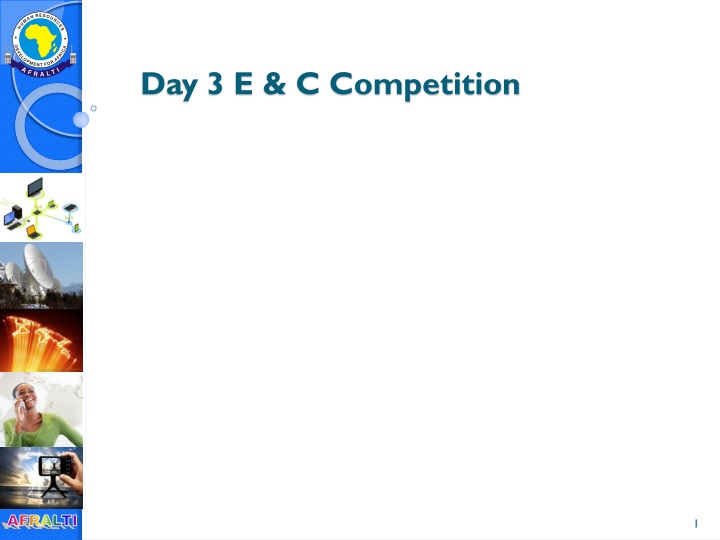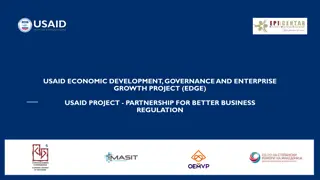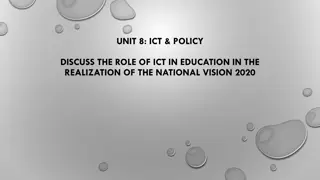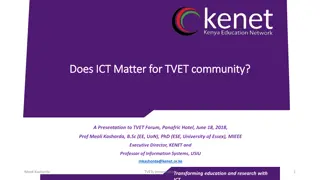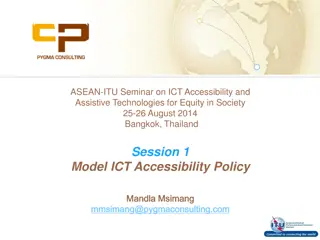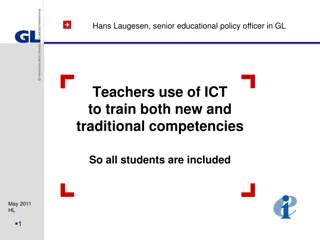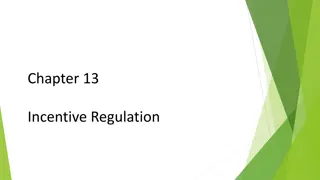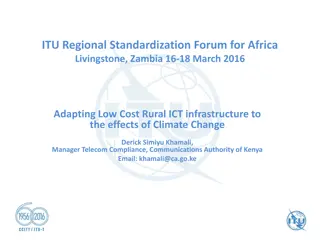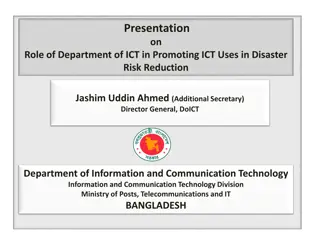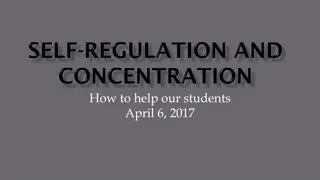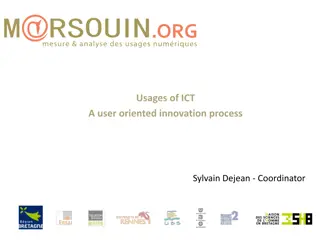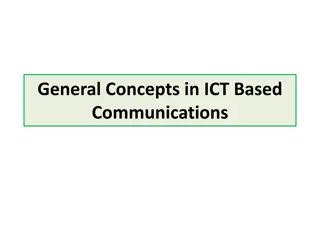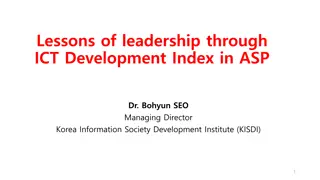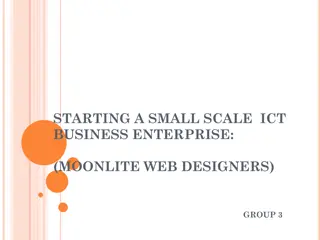Challenges and Opportunities in ICT Regulation
Addressing principal regulatory issues in the ICT market, this content delves into the impact of competition policy enforcement, compliance issues, and the regulation of fixed and wireless networks. It also explores the evolution of competition, challenges faced by developing countries, and key policy issues such as universal affordable access to communications and efficiency in the industry.
Download Presentation

Please find below an Image/Link to download the presentation.
The content on the website is provided AS IS for your information and personal use only. It may not be sold, licensed, or shared on other websites without obtaining consent from the author.If you encounter any issues during the download, it is possible that the publisher has removed the file from their server.
You are allowed to download the files provided on this website for personal or commercial use, subject to the condition that they are used lawfully. All files are the property of their respective owners.
The content on the website is provided AS IS for your information and personal use only. It may not be sold, licensed, or shared on other websites without obtaining consent from the author.
E N D
Presentation Transcript
Day 3 E & C Competition AFRALTI 1
Competition and Price Regulation Principal regulatory issues affecting ICT market. Guidance on competition policy enforcement and compliance issues, including interconnection and price regulation. Services resulting from convergence, such as VoIP, Impact of innovation on market structure. Regulation of Fixed and Wireless Networks Regulation of OTT services AFRALTI 2
Putting ICT Regulation in Context Challenges and Opportunities for Developing Countries Policy Issues Regulatory Issues Key Developments in the ICT Sector Evolution of Competition AFRALTI 3
Challenges and Opportunities for Developing Countries Lack of resources to build large costing models. Traditional fixed technologies are not deeply embedded, Regulators implement interconnection policies more appropriate to wireless networks, VoIP, and other emerging technologies Digitisation de-layers networks: -digitisation separates carriage and content services allowing over-the-top services which dramatically impact traditional business models which used content services (e.g. calls) to subsidise carriage (i.e. line rental). AFRALTI 4
Policy Issues Universal affordable access to communications: traditionally is about extending telephony services. supported by cross-subsidies from usage to access (or handsets in the case of mobiles). Is inconsistent with competition , but politically mandates social policies such as geographically uniform tariffs and can constrain the regulator s attempt to set cost-based tariffs in pursuit of efficiency objectives. Competition: Facilities-based competition (platform-based competition) which occurs between vertically-integrated players such as the telecommunications incumbent and a cable or mobile operator. If fibre broadband networks are a natural monopoly, the policy focus has shifted to service-based competition. Natural monopoly leads to interconnection, unbundling and infrastructure sharing policies. AFRALTI 5
Policy Issues Efficiency: Competition increases efficiency and drives prices towards costs. The cross subsidies from call revenues that promoted universal access with monopoly are not possible when there is competition for call revenue. The line rentals and local call prices have to go up so that long- distance prices can move towards cost. Policy may dictate how fast this should occur, often through price caps such policy should be reflected in both access and retail price regulation. The cross-subsidy from fixed to mobile users is being eliminated with rapid reductions in mobile termination rates. AFRALTI 6
Policy Issues Broadband: Ensuring widespread adoption of broadband is a key policy objective Since mobile broadband will be the main delivery platform in developing countries, a key policy task is the allocation of wireless spectrum. I Where the aim to upgrade copper networks with optical fibre, public investment is stepping-in where private investment lags. Innovation: a healthy ICT sector will see new services and applications constantly brought to market. Sometimes these may undermine existing service revenues. Examples of such game changing innovation are VoIP and Smartphone Apps. Private sector investment in the ICT sector: For this to occur, both policy and regulation must be clear and applied predictably and consistently. An unsolved investment issue is how to set the policy rules for public investment. AFRALTI 7
Regulatory Issues Regulation is second to competition in competitive markets. In competitive markets resources are distributed efficiently and fairly without any need for a single centralized controlling authority. Competition maximizes benefits to society at large by increasing: Allocative efficiency the optimal allocation of resources to meet consumer demand. Productive efficiency - achieved when resources are used to produce output at lowest cost Dynamic efficiency changes in efficiency over time, promoted where producers have incentives to invest and innovate to meet future consumer demand. AFRALTI 8
Regulatory Issues, 2 Regulation acts as a surrogate for competition where competitive forces are weak (e.g. forcing monopolies to reduce prices and increase output) or where there are significant externalities. Where regulation is a proxy for competition, the notions of efficiency are used to guide regulatory decisions; subject to policy. A trade-off between the long-term dynamic efficiency objective (investment) and the short-term allocative efficiency objective (lower prices) is necessary. Regulators are faced with a complex decisions to balance: The long term objective of ongoing, sustainable competition, and The resolution of immediate short-term concerns, while Complying with the legislative provisions AFRALTI 9
Regulatory Issues, 3 Using regulation to make markets more competitive must be done very carefully because the impact of the regulatory enforcement on competition may not be what was intended. Regulators may be tempted to micromanage the market to ensure that competition (or a particular form of competition) takes place. Alternatively, they may decide prematurely that the market is fully competitive. Neither of these paths is likely to result in sustainable competition. Regulators have to aim for principled, consistent and predictable decision-making. AFRALTI 10
Key Developments in ICT Sector Many regulatory decisions based on assumptions no longer reflect reality. Some regulators assume that: telecommunications mainly concerns voice calls. telecommunications networks remain natural monopolies. the firm that owns the network also provides the service The VoIP has demonstrated that the basic premise of traditional voice telephony is no longer relevant. Broadband technology in particular has made all three assumptions invalid AFRALTI 11
Key Developments in ICT Sector Both policy and regulation have to adapt to, but not over-react to, changes in the ICT sector. The nature and pace of change create challenges for both regulators and regulated firms. The key developments in the ICT sector, across four categories: Technological Changes The Emergence of New Services Changes in Market Structure Investment Issues in the Sector AFRALTI 12
Technological Change Digital technologies are changing the ways in which the majority of people live, work, play and interact with each other The most fundamental shift behind all these changes is the transition to all-digital networks which has profound implications for competition and regulation. Networks used to be built vertically around specific applications (e.g., voice or PayTV) but digitisation de- layers networks so that content or applications are no longer network specific. A byte is a byte and NGNs are layered to serve all applications. AFRALTI 13
Emergence of New Services Legacy access environment simple task to identify the carriage provider and the party to whom the carriage service is provided. All services are provided by an access provider, which charges for the telecommunications services acquired. Some telecommunication regulations assume that the provision of a service can be related to a specific carriage service or provider. Such assumptions may no longer be valid in a next generation access environment where the relationship between services and carriage may not be fixed or known. Next generation networks effectively remove legacy carriage technology barriers to provide a broad foundation for the development of applications and services in a converging industry. AFRALTI 14
Changes in Market Structure Convergence is blurring the boundaries between sectors. The historical distinctions between radio communications, telecommunications, broadcasting and the internet are blurring. Several jurisdictions have integrated their media and communications laws into a converged legislative framework. A common feature of converged legislative frameworks is the use of a regulatory model that is structured on the network layers of next generation networks, rather than on the vertical industry structures of telecommunications, broadcasting and IT. AFRALTI 15
Investment Issues in the Sector In the past, telecommunications operators have been viewed as stable, monopolistic utilities; the main challenge for regulators had been to prevent excessive retail pricing by incumbent operators. With increasing competition from new providers and new services, the telecommunications sector has become more volatile. Average revenues per line , or Average Revenue per User (ARPU) in case of mobile, from traditional services are declining under pressure from competing providers and modes of delivery. The emerging de-layered structure of the industry means that over-the-top applications (like Skype) have no intermediation by the carriage provider and take revenues directly from the end customer. This loss of revenues is happening to both fixed operators and, with smartphones, also mobile network providers. AFRALTI 16
Investment Issues in the Sector Network providers are expected to invest heavily in next generation fixed and wireless broadband networks. This may not happen fast enough to suit policy makers with regulatory implications for open access, competition and price regulation. A common reason for market intervention is market failure due to positive externalities . That is, investment in broadband is socially beneficial (public and private benefits exceed total costs) but private investment is not profitable (private costs exceed private benefits). This is most likely in rural areas where costs are high and demand is sparse, but may also occur in urban areas. Another form of market failure is due to natural monopoly . That is, duplication of fixed broadband access networks is uneconomic. That is of special concern to countries where investment resources are scarce. AFRALTI 17
Impact of the Regulation on Competition Regulators have to understand how competition is shaped by regulation and technology and the appropriate responses. Ideally the actions of the regulator should lead to the same outcomes expected in a competitive market. The costs of regulatory action may be higher than taking no action. With fast-moving technology, inaction may be less costly than regulation. The concept of the ladder of investment influenced many regulators who believed they could help new entrants towards facilities-based competition. The new entrants in developed markets have evolved through: Retail arbitrage (resale) Switched reseller Unbundled local loop Facility based (fibre) AFRALTI 18
Impact of the Regulation on Competition In developing markets, the addressable market for the above options is limited because the copper network in developing countries is less extensive. The mobile technology side steps the ladder because it allows infrastructure competition to occur immediately. These phases and the role of policy and the regulator: AFRALTI 19
Impact of Technology on Competition Before fibre arrived in the access network, a major assumption underlying the reliance on facilities-based competition where cable networks existed or open access where the copper network ruled - was that cable and telephone infrastructures already in place needed relatively low and largely symmetric cost upgrades to provide Internet services. The low incremental cost assumption has to be abandoned where fibre is deployed in the access network. The shared core understanding is that the transition to next generation infrastructures re-emphasizes the high upfront costs involved in, or natural monopoly, characteristics of, telecommunications networks, and requires some form of shared infrastructure if competition is to be maintained in the teeth of such economies of scale. AFRALTI 20
Impact of Technology on Competition At the same time, infrastructure competition is coming from mobile technology which has evolved to offer broadband. Broadband is increasingly viewed as a portable and nomadic service for the consumption of media rich content and video. Across all these network types, the biggest development which comes out of digitisation is the emergence of OTT applications. The OTT apps are especially disruptive because they undermine the business models of the network providers. For example, apps like Skype provide cheap voice. The apps can effectively kill the case for implementing Carrier Selection on fixed networks as the mobile market is far larger and smartphone penetration is already above fixed line penetration. AFRALTI 21
Level of Competition Globally Many countries have opened-up telecoms markets to new entrants, however, monopoly provision of local service is still prevalent in some regions; There are different approaches to development of broadband networks in relation to preferred platforms (mobile in the case of developing countries), The scope for infrastructure competition (natural monopoly in non-urban fixed networks) and the role of public investment (where private investment does not appear) varies. Competition for services is also emerging from non-traditional sources with digitisation. The separation of services and platforms (or carriage and content ) has profound implications for investment in business models and investment for networks. AFRALTI 22
Anti-Competitive Conduct This session discusses anti-competitive conduct issues and remedies. Specifically, address: Policy Issues Key Concepts Common Forms of Anti-Competitive Conduct Mergers, Acquisitions, and Joint Ventures AFRALTI 23
Policy Issues The aim of competition policy is to promote sustainable competition. Co-ordination across regulatory areas (broadcasting, data services, and telecommunications) to avoid regulatory arbitrage . Mergers between entities in previously separate sectors raise competition concerns. Many competitive conduct issues can be addressed by competition law. But, ex-ante regulation of conduct is quicker and cheaper. Regulators have to avoid over-react and be consistent and predictable. In emerging markets, forbearance is wise. Before concluding that either a merger would harm competition or that anti-competitive behavior exists in a market, to apply remedies competition analysis should be carried to: Define the relevant market or markets. Assess the level of competition in the market, with and without the trade practice or business acquisition in question. AFRALTI 24
Level of Effective Competition Assessing the level of effective competition include: Decide whether any firm in the market has significant market power and the impact of the trade practice or acquisition, question on its market power. a firm with market power has abused its position to raise prices above competitive levels or engage in anti-competitive practices, barriers to entry and exit, and role of any essential facilities. Anti-competitive behaviour may also be inhibited by imposing some form of separation between the incumbent s upstream and downstream (competitive) activities. AFRALTI 25
Defining the Market Market definition focuses on the substitutability of differentiated products or services. Other dimensions considered are: Product dimension the goods or services supplied and purchased; Geographic dimension the geographic area from which goods or services are obtained, or within which goods or services are supplied; Functional dimension level in production or distribution chain; Temporal dimension time frame or timing within which market operates, where relevant and; Customer dimension different customer types within a market, where relevant AFRALTI 26
CA Market Structure Under Unified Licence Framework National Network Facility Providers Tier 1: Nationwide licence, annual operating, frequency fees Tier 2: Regional allocation: licence, operating frequency fees Tier 3: County allocation: licence, operating and frequency fees International Network Facilities Providers International Gateway licence, annual operating fees Submarine Cable Landing licence and annual operating fees Non-Infrastructure Based Service Providers Application Service Providers (MVNOs, Vehicle Tracking, ccTDL) Content Service Provider relevant fees Electronic Certification Service Providers; relevant fees Others: Terminal Equipment, Technical Staff, Private VSATs One time authorization GMPCS landing; business processes outsourcing, Dot.ke Sub-domain registrar AFRALTI 27
Market Power Market power is only damaging if the firm concerned exercises its power. if the firm raises prices above competitive levels, would reduce demand, generate efficiency losses, and harm the public interest. Firms with market power may engage in anti- competitive behaviour. The EC defined the concept of SMP as the ability of a firm to act independently of competitors and customers. AFRALTI 28
Market Power, 2 The WTO defines dominance as the ability of an organisation to prevent effective competition being maintained in the relevant market by having the power to behave to an appreciable extent independently of its competitors, its providers, its customers and ultimately of the consumers. A high market share does not necessarily imply market power. A firm s market share may increase, at least temporarily, due to a successful new invention or better customer service. Market share in itself is neither necessary nor sufficient for market power. An incumbent telecommunications firm may have high market shares but as competition emerges, its market share cannot guarantee it the ability to charge prices higher than its competitors. AFRALTI 29
Separation There are three main forms for separating a dominant firm s competitive activity from its monopoly activities: Accounting separation Functional (operational) separation Structural separation Accounting separation: requires separate income statements and balance sheets to be maintained for the wholesale division and the retail units. a high level of aggregation and may not be able to detect a price squeeze. the benefit is that it preserves the vertically-integrated structure of the firm thereby preventing the loss of vertical efficiencies. On the other hand, it does not prevent non-price discrimination such as delays in switching customers to competitors. AFRALTI 30
Separation, 2 Functional (operational) separation requires the retail and wholesale arms of the vertically integrated dominant access provider to act independently of each other. Policing obligations for non-discrimination in vertically integrated operators is notoriously difficult. The six degrees of separation form a spectrum of options between the other two main forms of separation. Structural separation: is a last resort which requires an operator to separate its network infrastructure from its units offering services using this infrastructure. also known as 'ownership unbundling' or 'divestiture', means that all of the network elements are placed in a separate legal entity. AFRALTI 31
Common Forms of Anti- Competitive Conduct Abuse of Dominance Refusal to Supply , e.g. interconnection services Vertical Price Squeeze Cross-Subsidisation Misuse of Information Customer Lock-In Exclusionary or Predatory Pricing Tying and Bundling Non Discrimination and Net Neutrality AFRALTI 32
Abuse of Dominance A dominant firm engages in practices with the aim of eliminating or substantially lessening competition. Abuse of dominance may entail: Refusals to deal or supply an essential facility to a competitor, Exclusive dealing arrangements a seller prevents its distributors from selling competing products or services, Tying and bundling the purchase of one product or service conditional on the purchase of a second product or service, Predatory pricing prices below cost in order to force a competitor out of the market, Non-price predation adjusting the quality of product offering to customers with the aim of harming competitor, e.g., an incumbent might offer an improved level of service to customers served by one new entrant. AFRALTI 33
Remedies to Abuse of Dominance It is difficult to distinguish between aggressively competitive behaviour that harms individual competitors but benefits customers (for example by reducing prices), and behaviour that is anticompetitive because it harms competition. Appropriate remedy will depend on the specific nature and seriousness of the behaviour, and the likelihood of repeating the behaviour. Directive Remedies: injunctions or bans, require the firm to cease its abusive behaviour, or make specific changes to its behaviour so it is no longer damaging to competition. Punitive Remedies: fining the firm and ordering the firm to pay compensation to its competitors and/or customers. this must be weighed against the potential to chill competition. AFRALTI 34
Refusal to Supply Incumbent firms often control access to facilities that are essential inputs in the supply of services at the retail level. In the telecommunications sector, the local loop connecting end customers to the local exchange is often regarded as an essential facility. To encourage competition, requires firms with control over essential facilities to provide access to competitors. Rules may determine the way in which access prices will be agreed, and procedures for resolving any disputes. Refusal to supply may include deliberate delays and obstruction such as losing the keys to the exchange where a competitor has the right to co-locate equipment in an exchange under supervision. AFRALTI 35
Vertical Price Squeeze A firm which is vertically integrated and controls an essential input to the retail service implements a price squeeze if: The price demanded makes it impossible for an equally-efficient retail-stage competitor to operate profitably (or even survive); The firm does not charge its own downstream operation this high price. A price squeeze has a similar effect to a refusal to supply a facility. In the extreme, the firm might demand a price for the essential input that is higher than the full retail price of the service. Price squeeze remedies may include: resale obligations, price floors, or structural remedies These measures may achieve the objective of preventing a price squeeze, but can have substantial costs; Under structural separation the firm would lose any efficiencies or cost savings from vertical integration. AFRALTI 36
Cross-Subsidisation A cross-subsidy may be anti-competitive when a firm with market power prices services in less competitive markets higher so that it can have lower price for services it sells into competitive markets. Not all cross-subsidies are anti-competitive: telephone operators have cross-subsidized high-cost (under-priced) services from low- cost (over-priced) services. Competing is very good at attacking traditional cross-subsidy Regulators can assist incumbents with price rebalancing to meet competition, which increases line rentals so that call prices can fall. AFRALTI 37
Cross-Subsidisation, 2 Anti-competitive pricing can be difficult to identify. In telecommunications the network supports many different services, it is difficult to say which services are cross-subsidising others. Ideally, competition drives prices to marginal cost, but in network industries, the cost curve declines across the range of possible levels of output so prices must be set above marginal cost to recover all costs. The remedies for cross-subsidization are preventative in nature and often set either a price floor or require accounting separation to separate the costs of the firm s competitive and non-competitive products. AFRALTI 38
Misuse of Information Two of the three anti-competitive practices proscribed by the WTO concern misuse of information: engaging in anti-competitive cross-subsidization; using information obtained from competitors with anti- competitive results; and not making available to other services suppliers on a timely basis technical information about essential facilities and commercially relevant information necessary for them toprovide services. Remedies for misuse of information are ex ante, and include: Establishing strict rules or procedures for use or disclosure of commercially sensitive information, and setting limits on the sharing of sensitive information between a carrier and affiliates Win back rules, limiting the extent to which the vertically integrated firm may directly market to customers that choose to switch to a competitor. AFRALTI 39
Customer Lock-In Involves raising customers switching costs to the point that the cost of switching outweighs the potential benefits from switching. Switching costs may be: Transactional, e.g., cost of replacing existing equipment and technology needed to move to a different service provider, or Contractual, for example penalties for breaking an existing contract in order to switch to a new service provider. Contractual provisions that increase switching costs are not necessarily anti-competitive. Service providers may use contractual provisions that ensure customer loyalty to recover underlying costs over a period of time. Cases of lock-in need to be considered on a case by case basis, taking into account the degree of competition in the market, whether the firm in question has market power, or a dominant position, and the effect on competition. AFRALTI 40
Exclusionary or Predatory Pricing Predatory pricing is a pricing strategy used by a firm to eliminate competition from equally efficient firms, and secure a monopoly position in a competitive market. In order to have a reasonable expectation that the strategy will succeed, the firm must know: how long it must price below cost to force its competitors out of the market, the size of the loss that it must withstand while predatory pricing is in effect, and the probability that it will recover its losses once it has achieved a monopoly. AFRALTI 41
Exclusionary or Predatory Pricing, 2 It can be difficult in practice to distinguish predatory pricing from aggressively competitive below cost pricing (such as loss leaders and promotional activities). Ex post antitrust remedies, such as fines or compensation, may be available for proven instances of predatory pricing. Predatory pricing is difficult to prove with sufficient certainty to justify punitive measures. A more useful remedy for predatory pricing is an appropriate price floor for the affected product or service. This is a preventive remedy, requiring ex-ante regulation. AFRALTI 42
Tying and Bundling Tying of services: Occurs when a service provider makes the purchase of one product or service over which it has market power (the "tying good") conditional on the purchase of a second, competitively supplied, product or service (the "tied good"). By tying services, a service provider can try to use market power in one market to give itself an advantage in another, competitive market. AFRALTI 43
Tying and Bundling, 2 Service bundling: occurs where a service provider offers two or more services separately, but gives a discount to customers who purchase the services as a combined bundle. is common in telecommunications and other multiproduct industries, reflecting both cost savings from producing services jointly, and consumer preferences for service bundles. local and long distance services are often bundled with services such as call waiting, call forwarding, voice mail, or Internet access. Bundling is generally a pro-competitive, and customer friendly, strategy. As such bundling does not call for regulatory intervention. AFRALTI 44
Non Discrimination and Net Neutrality The Internet has flourished in part due to a hands off approach by governments and the apparent willingness of all stakeholders to cooperate and self-regulate. As the amount of video traffic increases, carriers may feel the need to adopt network management practices to control congestion of their networks. Some carriers may try to take the opportunity to extract value by prioritizing traffic in ways which violate the tradition of network neutrality. Regulators are moving tentatively to decide how far they need to intervene. While many see the need for transparency about traffic management rules, only a few have moved to set traffic management rules. AFRALTI 45
Mergers, Acquisitions and Joint Ventures These are all different ways for two or more firms to integrate or coordinate their operations: A merger is a structural fusion of two firms that results in a common ownership and management structure. An acquisition is a type of merger in which a firm with more resources and greater market strength may acquire another firm. A joint venture is a strategic alliance between two firms that share resources, equity, revenues, expenses, and management to pursue a common goal. AFRALTI 46
Mergers, Acquisitions and Joint Ventures, 2 Motivated by factors such as: cost savings from synergies between the firms, economies of scale and scope, efficiencies from vertical integration, geographical diversification or cross-selling of products. Provisions governing mergers and acquisition are generally included in competition or antitrust laws, where these exist; Investigation of proposed mergers is usually the responsibility of a competition authority; In countries with both a competition authority and a telecommunications regulator, both agencies may have a mandate to investigate mergers in the telecommunications sector. AFRALTI 47
Mergers and Acquisitions Mergers can be: horizontal - bringing together firms that produce the same product within the same market or vertical bringing together firms in potential customer- supplier relationships. Horizontal mergers by definition, reduce the number of actual competitors, and may produce cost savings and other benefits. If the benefits of horizontal merger outweigh any reduction in competition, then the merger should be allowed to proceed. AFRALTI 48
Mergers and Acquisitions, 2 If found to generate benefits that don t outweigh the damage to competition, then NRAs may impose ex ante obligations on merged firm. The NRA may impose conditions on a merger that would otherwise be anti-competitive. Vertical mergers involve complementary services while horizontal mergers involve substitute services. are more likely to increase efficiency than horizontal mergers but may raise competition concerns in limited sets of circumstances. AFRALTI 49
Joint Ventures Joint ventures can have many different objectives, and have different implications for competition. Telecommunications joint ventures raise three broad types of competition concern: The potential for collusion among the parties in the joint venture, A loss of potential competition, and The potential for market exclusion and access discrimination. Joint ventures with the purpose of fixing prices, restricting output, or allocating markets between firms reduce competition, and generally should not be permitted. Regulators or competition authorities should consider whether the joint venture will increase market power sufficiently to cause a substantial lessening of competition. AFRALTI 50
